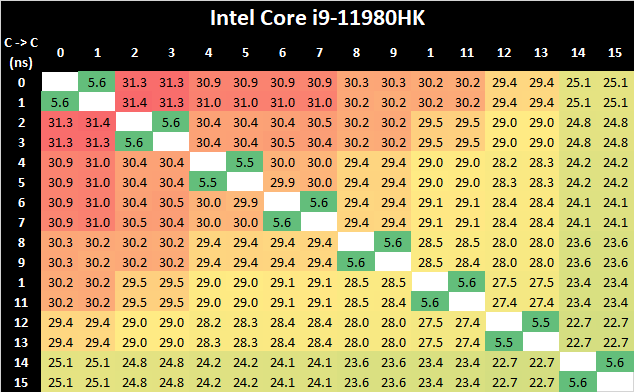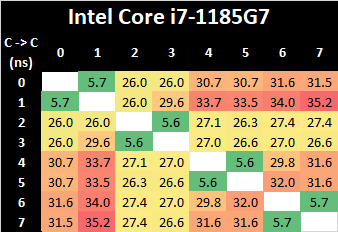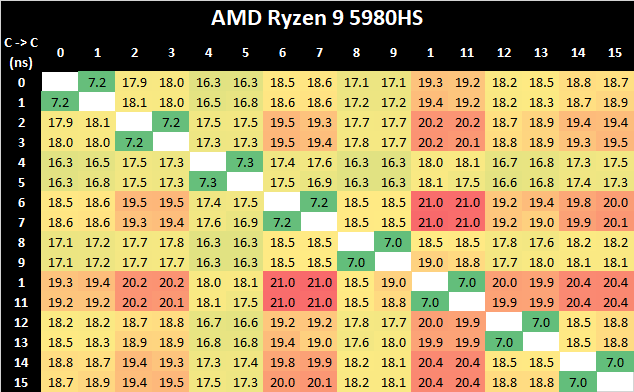Intel 11th Generation Core Tiger Lake-H Performance Review: Fast and Power Hungry
by Brett Howse & Andrei Frumusanu on May 17, 2021 9:00 AM EST- Posted in
- CPUs
- Intel
- 10nm
- Willow Cove
- SuperFin
- 11th Gen
- Tiger Lake-H
CPU Tests: Microbenchmarks
Core-to-Core Latency
As the core count of modern CPUs is growing, we are reaching a time when the time to access each core from a different core is no longer a constant. Even before the advent of heterogeneous SoC designs, processors built on large rings or meshes can have different latencies to access the nearest core compared to the furthest core. This rings true especially in multi-socket server environments.
But modern CPUs, even desktop and consumer CPUs, can have variable access latency to get to another core. For example, in the first generation Threadripper CPUs, we had four chips on the package, each with 8 threads, and each with a different core-to-core latency depending on if it was on-die or off-die. This gets more complex with products like Lakefield, which has two different communication buses depending on which core is talking to which.
If you are a regular reader of AnandTech’s CPU reviews, you will recognize our Core-to-Core latency test. It’s a great way to show exactly how groups of cores are laid out on the silicon. This is a custom in-house test built by Andrei, and we know there are competing tests out there, but we feel ours is the most accurate to how quick an access between two cores can happen.
In terms of the core-to-core tests on the Tiger Lake-H 11980HK, it’s best to actually compare results 1:1 alongside the 4-core Tiger Lake design such as the i7-1185G7:
What’s very interesting in these results is that although the new 8-core design features double the cores, representing a larger ring-bus with more ring stops and cache slices, is that the core-to-core latencies are actually lower both in terms of best-case and worst-case results compared to the 4-core Tiger Lake chip.
This is generally a bit perplexing and confusing, generally the one thing to account for such a difference would be either faster CPU frequencies, or a faster clock of lower cycle latency of the L3 and the ring bus. Given that TGL-H comes 8 months after TGL-U, it is plausible that the newer chip has a more matured implementation and Intel would have been able to optimise access latencies.
Due to AMD’s recent shift to a 8-core core complex, Intel no longer has an advantage in core-to-core latencies this generation, and AMD’s more hierarchical cache structure and interconnect fabric is able to showcase better performance.
Cache & DRAM Latency
This is another in-house test built by Andrei, which showcases the access latency at all the points in the cache hierarchy for a single core. We start at 2 KiB, and probe the latency all the way through to 256 MB, which for most CPUs sits inside the DRAM (before you start saying 64-core TR has 256 MB of L3, it’s only 16 MB per core, so at 20 MB you are in DRAM).
Part of this test helps us understand the range of latencies for accessing a given level of cache, but also the transition between the cache levels gives insight into how different parts of the cache microarchitecture work, such as TLBs. As CPU microarchitects look at interesting and novel ways to design caches upon caches inside caches, this basic test proves to be very valuable.
What’s of particular note for TGL-H is the fact that the new higher-end chip does not have support for LPDDR4, instead exclusively relying on DDR4-3200 as on this reference laptop configuration. This does favour the chip in terms of memory latency, which now falls in at a measured 101ns versus 108ns on the reference TGL-U platform we tested last year, but does come at a cost of memory bandwidth, which is now only reaching a theoretical peak of 51.2GB/s instead of 68.2GB/s – even with double the core count.
What’s in favour of the TGL-H system is the increased L3 cache from 12MB to 24MB – this is still 3MB per core slice as on TGL-U, so it does come with the newer L3 design which was introduced in TGL-U. Nevertheless, this fact, we do see some differences in the L3 behaviour; the TGL-H system has slightly higher access latencies at the same test depth than the TGL-U system, even accounting for the fact that the TGL-H CPUs are clocked slightly higher and have better L1 and L2 latencies. This is an interesting contradiction in context of the improved core-to-core latency results we just saw before, which means that for the latter Intel did make some changes to the fabric. Furthermore, we see flatter access latencies across the L3 depth, which isn’t quite how the TGL-U system behaved, meaning Intel definitely has made some changes as to how the L3 is accessed.














229 Comments
View All Comments
HendoAuScBa - Tuesday, May 18, 2021 - link
How confident are you with that Compile test result? You have the i9-11980HK at 86.9 compiles per day which is a huge jump higher than the best desktop CPUs listed on your benchmark page (the best of which is the i9-11900K at 77).https://www.anandtech.com/bench/CPU-2020/2974
Also, that benchmark page is missing Zen 3 mobile results that you've included in this article.
mode_13h - Tuesday, May 18, 2021 - link
It's eye-catcing, alright. I was also wondering about it.Could it be due to the laptop simply having more RAM or an Optane SSD or something? Mitigations are another thing that comes to mind.
RobJoy - Tuesday, May 18, 2021 - link
Intel is about 1.5 years behind the competition.Once their 5nm fab starts puking out some silicon, we might see them return in the fold.
But that's like 2023 or even 2024.
Until then, accept the fact that Intel HAS competition.
mode_13h - Tuesday, May 18, 2021 - link
> puking out some siliconLOL. I used to work with a guy who used another bodily function as an analogy for the operation of a systolic pipeline. You wouldn't have to think very hard to guess it.
usiname - Tuesday, May 18, 2021 - link
More like 2025, i doubt they will realese just 1 gen with 7nm and will rush to new processdrothgery - Wednesday, May 19, 2021 - link
I wouldn't be shocked to see them rebrand their "7nm" as something with a 5 in it that gets called "5nm" by the press; it wouldn't be unreasonable.LordSojar - Tuesday, May 18, 2021 - link
Good lord the power consumption on these chips... Intel DESPERATELY needs 7nm.usiname - Tuesday, May 18, 2021 - link
You know their 10nm has same transistor density as 7nm TSMC? They don't need new proces, they need new engineersmode_13h - Tuesday, May 18, 2021 - link
> their 10nm has same transistor density as 7nm TSMC?Which 10 nm, though? From what I heard, Ice Lake's density is lower than Cannon Lake's. And I'm not sure if SF or ESF reduced it, further.
Otritus - Wednesday, May 19, 2021 - link
Ice lake having a lower density isn't demonstrative of differences in process density. When designing Sunny Cove, the engineers may not have cared about density, and instead focused on performance and efficiency, resulting in Sunny Cove being less dense than Palm Cove (Cannon Lake). Intel's 10nm being slightly denser than TSMC's 7nm also doesn't mean that it is more efficient. When moving from TSMC's less-dense 7nm to Samsung's more-dense 5nm, mobile SOCs appeared to suffer from a regression in efficiency. Intel needs a node that is both performant and efficient and better engineering because their architectures are clearly less efficient than the competition. Golden Cove might fix Willow Cove's poor density and performance per watt, or we might be waiting till 2023-4 when Intel expects to be properly competitive again.